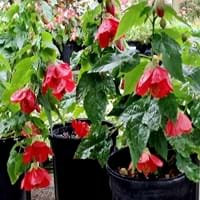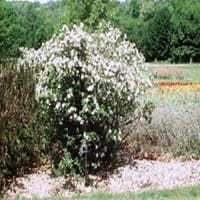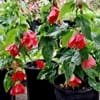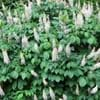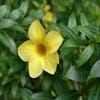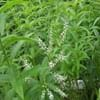Life Span
Annual
Perennial
Type
Tender Perennial
Shrub
Origin
Hybrid origin
North America, United States, Northeastern United States, Mid-Atlantic United States, Southeastern United States, Canada
Types
Not available
Red chokeberry, Purple chokeberry
Habitat
subtropical regions
Anthropogenic, Boggy areas, Cliffs, Fens, Swamps, Terrestrial, Wet lands, Woodlands
USDA Hardiness Zone
8-10
3-8
Sunset Zone
H1, H2, 8, 9, 12, 13, 14, 15, 16, 17, 18, 19, 20, 21, 22, 23, 24
A2, A3, 1a, 1b, 2a, 2b, 3a, 3b, 4, 5, 6, 7
Habit
Oval or Rounded
Thicket/Colonizing
Flower Color
Pink, Peach
Not Available
Flower Color Modifier
Not Available
Not Available
Fruit Color
Not Available
Purplish-black
Leaf Color in Spring
Green, Gray Green, Dark Green, Ivory
Not Available
Leaf Color in Summer
Green, Gray Green, Dark Green, Ivory
Not Available
Leaf Color in Fall
Green, Gray Green, Dark Green, Ivory
Not Available
Leaf Color in Winter
Green, Gray Green, Dark Green, Ivory
Not Available
Leaf Shape
Maple shaped
Elliptic
Plant Season
Spring, Summer, Fall, Winter
Spring, Summer, Fall
Sunlight
Full Sun, Partial Sun
Full Sun, Partial Sun, Partial shade
Type of Soil
Loam, Sand
Clay, Loam
The pH of Soil
Acidic, Neutral, Alkaline
Acidic, Neutral, Alkaline
Soil Drainage
Well drained
Average
Bloom Time
Indeterminate
Late Spring, Early Summer
Tolerances
Not Available
Not Available
Where to Plant?
Ground, Pot
Ground, Pot
How to Plant?
Cuttings, Seedlings
Cuttings, Divison, Seedlings
Plant Maintenance
Medium
Medium
Watering Requirements
Do Not over Water, Keep ground moist, Keep the Soil well drained, Requires regular watering
Average Water Needs, Do Not over Water, Requires regular watering
In Summer
Lots of watering
Lots of watering
In Spring
Moderate
Moderate
In Winter
Average Water
Average Water
Soil pH
Acidic, Neutral, Alkaline
Acidic, Neutral, Alkaline
Soil Type
Loam, Sand
Clay, Loam
Soil Drainage Capacity
Well drained
Average
Sun Exposure
Full Sun, Partial Sun
Full Sun, Partial Sun, Partial shade
Pruning
Prune to stimulate growth, Remove damaged leaves, Remove dead branches, Remove dead leaves
Prune after flowering, Remove branches that rub together, Remove damaged leaves, Remove dead branches, Remove dead leaves, Remove diseased branches by the tool's blades dipped into the alcohol solution
Fertilizers
20-20-20 amount
10-10-10, All-Purpose Liquid Fertilizer, Apply N-P-K
Pests and Diseases
Abutilon mosaic virus, Aphids, Beetles, Scale
Red blotch
Plant Tolerance
Not Applicable
Not Available
Flower Petal Number
Single
Not Available
Foliage Texture
Medium
Not Available
Foliage Sheen
Matte
Not Available
Attracts
Butterflies, Flying insects, Hummingbirds
Not Available
Allergy
Not Available
Anaphylaxis
Aesthetic Uses
Beautification, Bonsai, Cut Flowers, Decorating walls, Hanging Basket, small hedge, Used as an interior landscaping species
Showy Purposes
Beauty Benefits
Not Available
Good for skin
Environmental Uses
Air purification
Air purification, Food for birds, Wildlife
Medicinal Uses
Not Available
anti-cancer, Antioxidants, Cold
Part of Plant Used
Not Available
Fruits
Other Uses
Cut Flowers, Decoration Purposes, Grown in botanical gardens as a specimen, Used as Ornamental plant, Used for Landscaping
Pectin
Used As Indoor Plant
No
No
Used As Outdoor Plant
Yes
Yes
Garden Design
Bedding Plant, Container, Feature Plant, Foundation, Hedges, Mixed Border, Topiary / Bonsai / Espalier, Tropical
Foundation, Mixed Border
Botanical Name
ABUTILON 'Savitzii'
ARONIA melanocarpa
Common Name
Flowering Maple, Parlour Maple
Black Chokeberry
In Hindi
flowering maple
Black Chokeberry Shrub
In German
Schönmalve
Schwarz Aronia Strauch
In French
érable floraison
Noir Chokeberry Arbuste
In Spanish
arce de floración
Chokeberry negro Arbusto
In Greek
ανθοφορία σφενδάμου
Μαύρο Chokeberry θάμνων
In Portuguese
de bordo florescimento
Chokeberry preto Arbusto
In Polish
klon kwitnienia
Krzew aronii
In Latin
Abutilon
Lichen Frutex
Phylum
Magnoliophyta
Magnoliophyta
Class
Magnoliopsida
Magnoliopsida
Family
Malvaceae
Rosaceae
Clade
Angiosperms, Rosids
Angiosperms, Eudicots, Rosids
Subfamily
Malvoideae
Amygdaloideae
Number of Species
Not Available
Importance of Flowering Maple and Black Chokeberry
Want to have the most appropriate plant for your garden? You might want to know the importance of Flowering Maple and Black Chokeberry. Basically, these two plants vary in many aspects. Compare Flowering Maple and Black Chokeberry as they differ in many characteristics such as their life, care, benefits, facts, etc. Every gardener must at least have the slightest clue about the plants he wants to plant in his garden. Compare their benefits, which differ in many ways like facts and uses. The medicinal use of Flowering Maple is Not Available whereas of Black Chokeberry is anti-cancer, Antioxidants and Cold. Flowering Maple has beauty benefits as follows: Not Available while Black Chokeberry has beauty benefits as follows: Not Available.
Compare Facts of Flowering Maple vs Black Chokeberry
How to choose the best garden plant for your garden depending upon its facts? Here garden plant comparison will help you to solve this query. Compare the facts of Flowering Maple vs Black Chokeberry and know which one to choose. As garden plants have benefits and other uses, allergy is also a major drawback of plants for some people. Allergic reactions of Flowering Maple are Not Available whereas of Black Chokeberry have Anaphylaxis respectively. Having a fruit bearing plant in your garden can be a plus point of your garden. Flowering Maple has no showy fruits and Black Chokeberry has showy fruits. Also Flowering Maple is not flowering and Black Chokeberry is flowering. You can compare Flowering Maple and Black Chokeberry facts and facts of other plants too.
